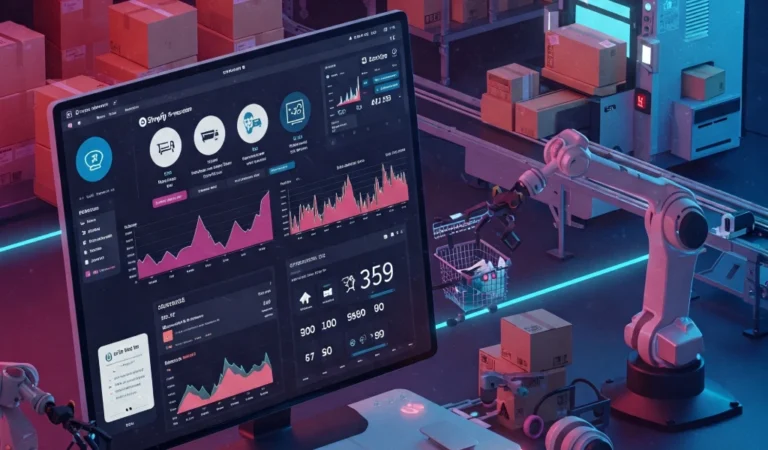In 2025, running an online business is no longer a grind—it’s an algorithmic masterpiece. The rise of AI tools has made it possible to build a Shopify store that practically runs itself. Imagine launching a store where product sourcing, design, pricing, copywriting, marketing, customer service, and inventory updates are all handled by artificial intelligence. This isn’t the future—it’s now.
If you’re ready to go hands-off and let the machines hustle for you, here’s how to build a fully AI-run Shopify store in 2025, step-by-step.
Step 1: Pick Your Niche—Let AI Help You Decide
You don’t need hours of market research. Use tools like Exploding Topics or Google Trends (AI-enhanced version) to identify trending niches. Then plug potential product ideas into:
- ChatGPT (o4 / GPT-4.5) with a custom prompt to find underserved niches.
- TrendHunter AI to analyze long-term growth patterns.
- Shopify Magic for AI-backed store ideas.
Pro Tip: Focus on AI-relevant niches like smart home devices, wearable health tech, or AI-driven pet gadgets.
Step 2: Source Products Using AI Aggregators
Forget AliExpress scrolling. Use AI-driven dropshipping platforms that sync with Shopify:
- DropCommerce AI: Offers predictive sourcing and profit margin calculators.
- Zendrop Plus AI: Suggests high-velocity products and automatically updates inventory and delivery estimates.
- Spocket AI Assistant: Recommends suppliers based on your niche, shipping speed, and margins.
Want to stand out? Combine product ideas with Midjourney or DALL·E 3 to generate custom product designs, then use Printify AI for on-demand manufacturing.
Step 3: Generate a Full Brand Kit With AI
Your Shopify store needs to look legit. Use:
- Looka or Brandmark.io: Auto-generate your logo, brand colors, and typography.
- Namelix AI: For unique, brandable store names.
- Zyro AI Writer or Jasper AI: To craft your About Us, mission statement, and product category blurbs.
Upload everything into Shopify and let it sync across your theme. You can also use Shopify Magic to auto-generate content sections dynamically.
Step 4: Use AI to Write Killer Product Descriptions
No one wants to read a bland product description in 2025. Use tools that create persuasive, SEO-optimized descriptions:
- ChatGPT with an ecommerce prompt template
- Copysmith.ai
- Hypotenuse AI
Be sure to include:
- Emotional benefits
- Technical specs
- A strong call-to-action
- SEO keywords suggested by SurferSEO AI or Frase.io
You can set up Shopify to auto-import product descriptions using an AI content pipeline.
Step 5: Auto-Optimize Your Store’s SEO
Shopify SEO in 2025 is mostly automated if you know the tools:
- SmartSEO or Plug In SEO AI: Audits and fixes meta tags, image alt texts, and schema.
- NeuronWriter or SurferSEO: Help optimize blog content around your store’s niche keywords.
- Shopify’s AI SEO Assistant: Auto-generates title tags, meta descriptions, and keyword-rich URLs for each product and collection page.
Pro Tip: Add schema markup (FAQ, Product, and Breadcrumbs) using SchemaPlus AI to boost your CTR in Google’s rich results.
Step 6: Create AI-Powered Product Images & Videos
Forget expensive photoshoots. Use:
- Midjourney or DALL·E 3: Create photorealistic product images.
- RunwayML: Generate product demo videos using AI avatars.
- Kaiber or Pika: Make dynamic video ads or unboxing animations.
Shopify’s new media engine in 2025 lets you upload these assets directly and auto-generates thumbnails and alt-text.
Step 7: Automate Email & SMS Marketing
Why hire a marketer when AI does it better?
- Klaviyo AI: Syncs with Shopify, tracks behavior, and sends personalized email/SMS flows.
- Omnisend: AI-created abandoned cart sequences and product recommendations.
- Shopify Flow + ChatGPT API: Custom trigger-based campaigns (e.g., “Send discount when user lingers 30s on product page”).
You can A/B test subject lines and offers automatically and let AI optimize your conversions.
Step 8: Add a Fully AI-Driven Chatbot & Support System
Customer service is now AI-first. Try:
- Tidio AI or Re:amaze AI: Understand complex queries and offer 24/7 chat support.
- ChatGPT API + Shopify: Build a custom chatbot trained on your product FAQs, return policy, and brand tone.
- Zendesk AI: Automates ticket routing, responses, and multilingual support.
These bots can now upsell products, recover carts, and even issue refunds—without a human.
Step 9: Let AI Run Your Paid Ads and Organic Growth
AI tools now manage your full marketing funnel:
- AdCreative.ai: Instantly generates Facebook, Instagram, and TikTok ad creatives.
- Copy.ai Ads Generator: For persuasive headlines and copy.
- Pencil AI: Learns from your store’s data and runs self-optimizing ad campaigns.
- Shopify Collabs AI: Finds the best micro-influencers to promote your niche.
Pair this with a content engine using Jasper or KoalaWriter for SEO blogs and link-building.
Step 10: Manage Orders, Analytics & Growth on Autopilot
Finally, you can integrate AI for logistics and growth:
- Shopify AI Analytics (2025 edition): Predicts which products to restock, when, and how much.
- BeProfit AI: Real-time profit tracking across products, channels, and geographies.
- Fulfillrite AI or ShipBob AI: Handle warehousing, packaging, and shipping with smart forecasts.
Even upsells and cross-sells are automated using ReConvert AI or LimeSpot AI.
Can You Really Run a Store Without Lifting a Finger?
Pretty much. In 2025, your job as a Shopify store owner is to oversee, not do. You can monitor dashboards, approve AI suggestions, and tweak prompts. That’s it.
Want to take it even further? Set up Zapier or Make.com automations between all your tools. Your Shopify store becomes a digital vending machine that scales itself.
Final Thoughts: The Rise of the AI Solopreneur
Welcome to the era of the AI solopreneur—where one person with the right tech stack can run an ecommerce empire from a beach in Bali or a couch in Brooklyn.
Building a fully AI-run Shopify store in 2025 isn’t just possible—it’s profitable, scalable, and totally badass.
All you need is a smart setup, a sprinkle of creativity, and the guts to let AI take the wheel.


